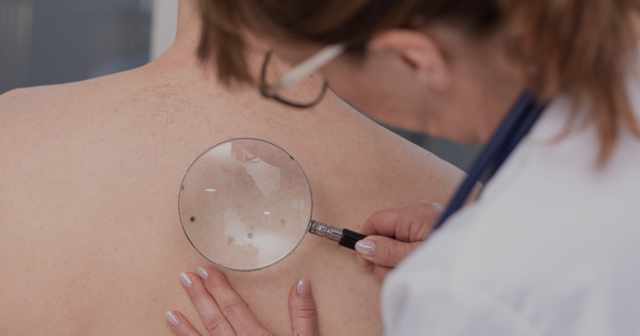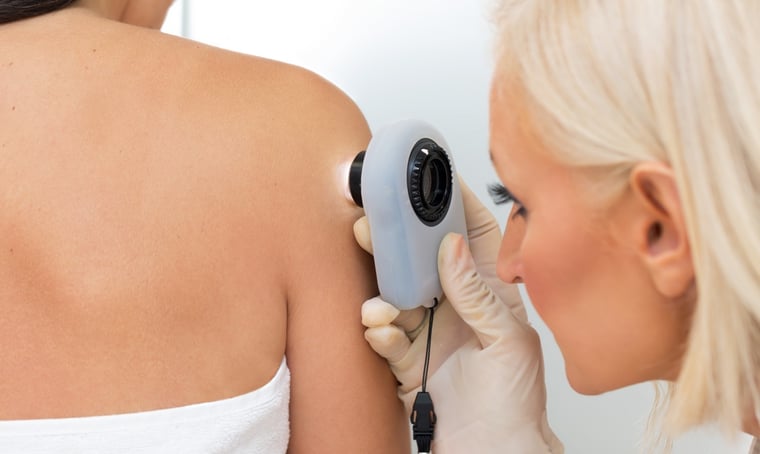

Mole Treatment
in Grand Haven, MI
What Are Moles?
Moles, also called nevi, are an extremely common type of skin growth. They can develop anywhere on the body and are typically brown in color, although they can also appear black, tan, pink, blue, or red. Most moles have an oval or round shape, and they commonly develop during childhood or adolescence.
It’s normal for some moles to have hair growing from them, and it’s common for some moles to lighten or darken in color or even fade away over time. Although most moles are harmless, you should always monitor them for any changes in their appearance. This is an important step in the early detection of cancerous moles. Melanoma is the most serious form of skin cancer.
BOOK NOWAre There Different Types of Moles?

There are three types of moles that are the most common. Let’s take a closer look at each type:
Congenital mole: A congenital mole is any type of mole you’re born with. They can vary in color and are typically flat in appearance. According to the American Academy of Dermatology (AAD), having a congenital mole increases your risk of developing melanoma.
Atypical mole: This type of mole is also called a dysplastic nevus and is larger in size than a common mole. They often have irregular-shaped borders and can be more than one color. These moles can appear on most areas of the body, including your torso, scalp, and neck.
Common mole: Common moles, known as acquired moles, develop on the skin after birth. Most people typically have around 10-40 common moles, and they’re usually found on areas of the skin that are commonly exposed to sunlight.

How Do I Know If a Mole Is Cancerous?
Although most moles are harmless, melanoma can occur in a mole. This is why it’s important to know your skin and become familiar with the appearance of any moles you have. If you notice any changes in a mole, it’s important to bring it to the attention of your primary care provider or dermatologist. Melanoma is very treatable when caught early.
According to the American Cancer Society, an atypical mole is more likely to become cancerous in comparison to a common mole. Cancerous moles can vary in appearance. Your doctor should evaluate moles that feel painful, tender, itch, bleed, or ooze. You should also have moles checked if you notice any difference in a mole’s shape, color, size, or height. The AAD also recommends visiting a dermatologist for an evaluation if you develop a new mole anywhere on your body after age 30.
What Causes Moles?

Moles develop when cells in the skin grow in large clumps or clusters instead of spreading evenly throughout the skin. These skin cells are called melanocytes, and they’re responsible for producing melanin, which gives your skin its pigment. Anyone can develop moles, but these factors can increase the likelihood of developing them:
- Genetics
- Age
- Hormonal changes, such as pregnancy
- Frequent sun exposure
When Is Mole Removal Necessary?
Unless they’re cancerous, most moles don’t require treatment. You might choose to have a mole removed if it’s easily irritated or frequently snags on clothing or jewelry. Some people also choose to have a mole removed for cosmetic reasons, such as a large or noticeable mole on the face or neck.
Remember, a dermatologist or other healthcare professional should always perform mole removal. Never attempt to remove a mole on your own. If you’re asking friends or family, “Is there a trusted doctor for mole removal near me?”, look no further than our office. Your doctor may recommend one of these treatment options:
Surgical shave: Using a surgical blade, the dermatologist will remove the mole at the surface.
Surgical excision: During this procedure, the dermatologist will cut out the entire mole. If needed, the area will be closed with stitches.
If a mole is removed with a surgical shave or a surgical excision, a doctor may examine the mole closely under a microscope to detect cancerous cells.
How Much Does Mole Removal Cost?
The mole removal cost can vary greatly and depends on a variety of factors. Insurance usually covers mole removal for medical reasons, including those that are precancerous or cancerous. Most moles removed for cosmetic reasons typically aren’t covered by insurance. The total cost for removal is also influenced by the mole’s size and location on the body.
Where Can I Find a Doctor Who Performs Mole Removal Near Me?
If you’re wondering, “What kind of doctor offers mole removal near me?”, it’s important that you seek care from a board-certified dermatologist. These specialists receive extensive training that enables them to safely remove moles and minimize scarring. They can also carefully examine moles for the early signs of melanoma.
To schedule a comprehensive skin evaluation from one of our expert dermatologists, please contact us today. We look forward to serving you!
1 Location in the Grand Haven, MI area
Booking an appointment has never been easier.
Available 24/7.